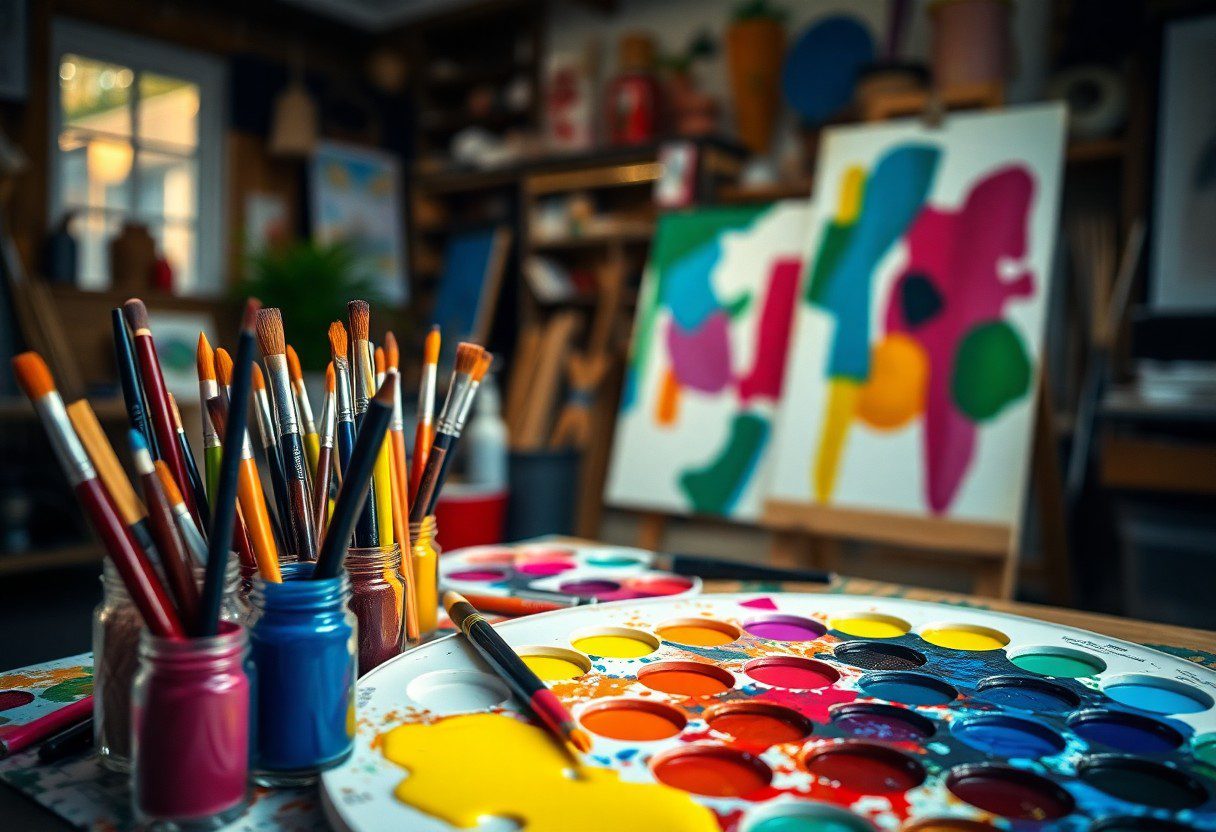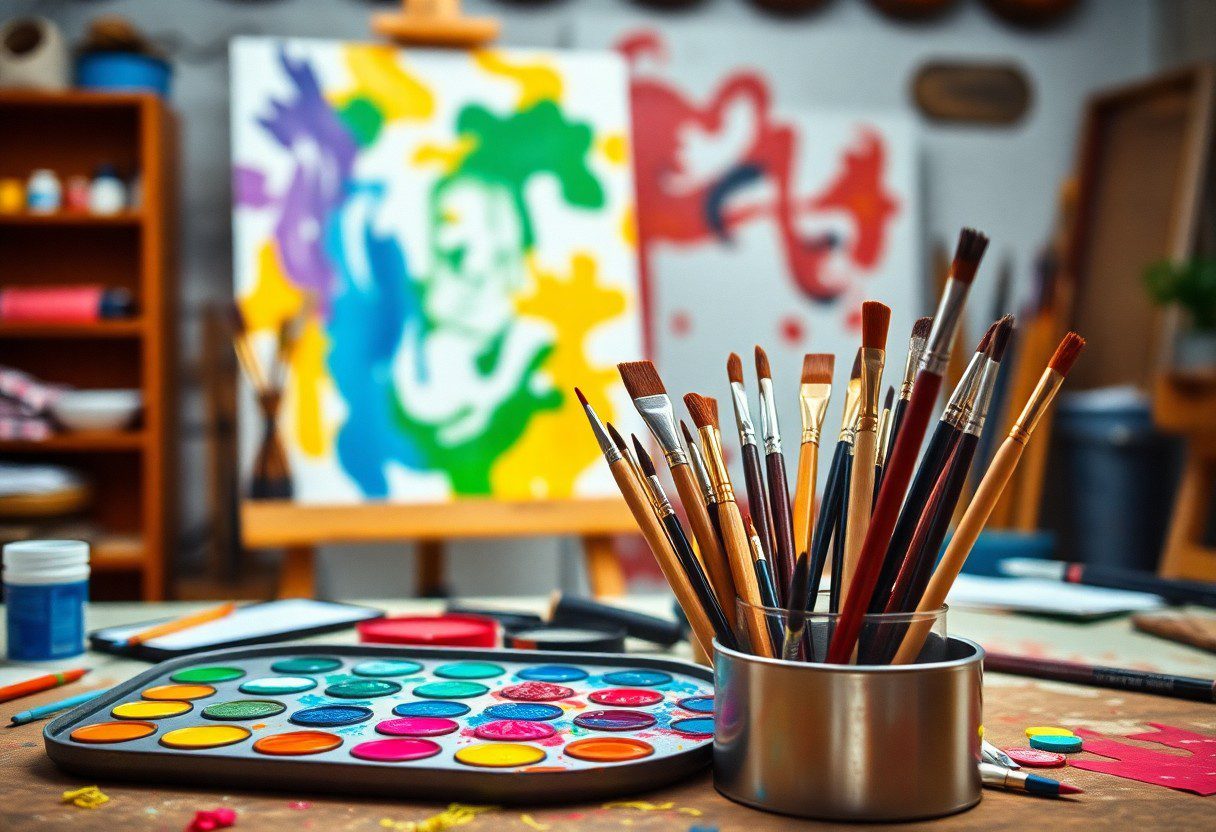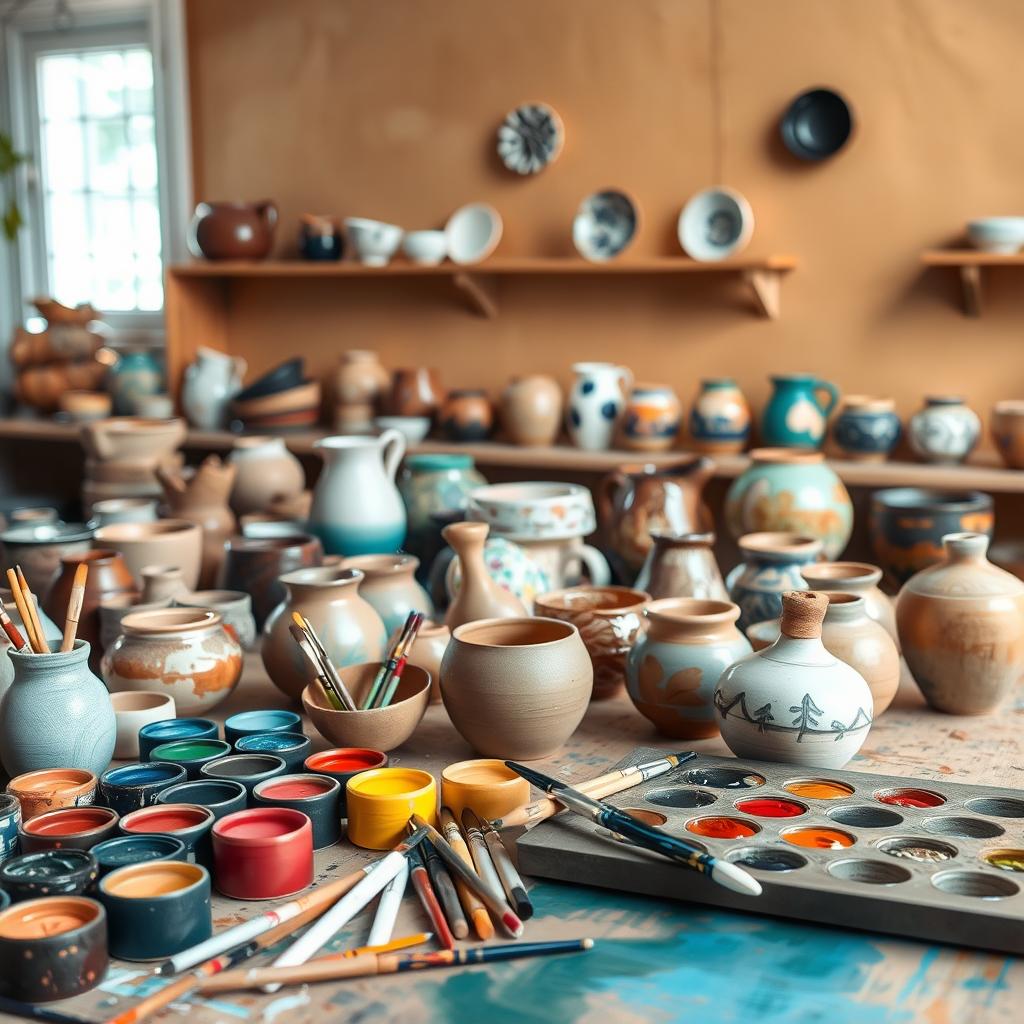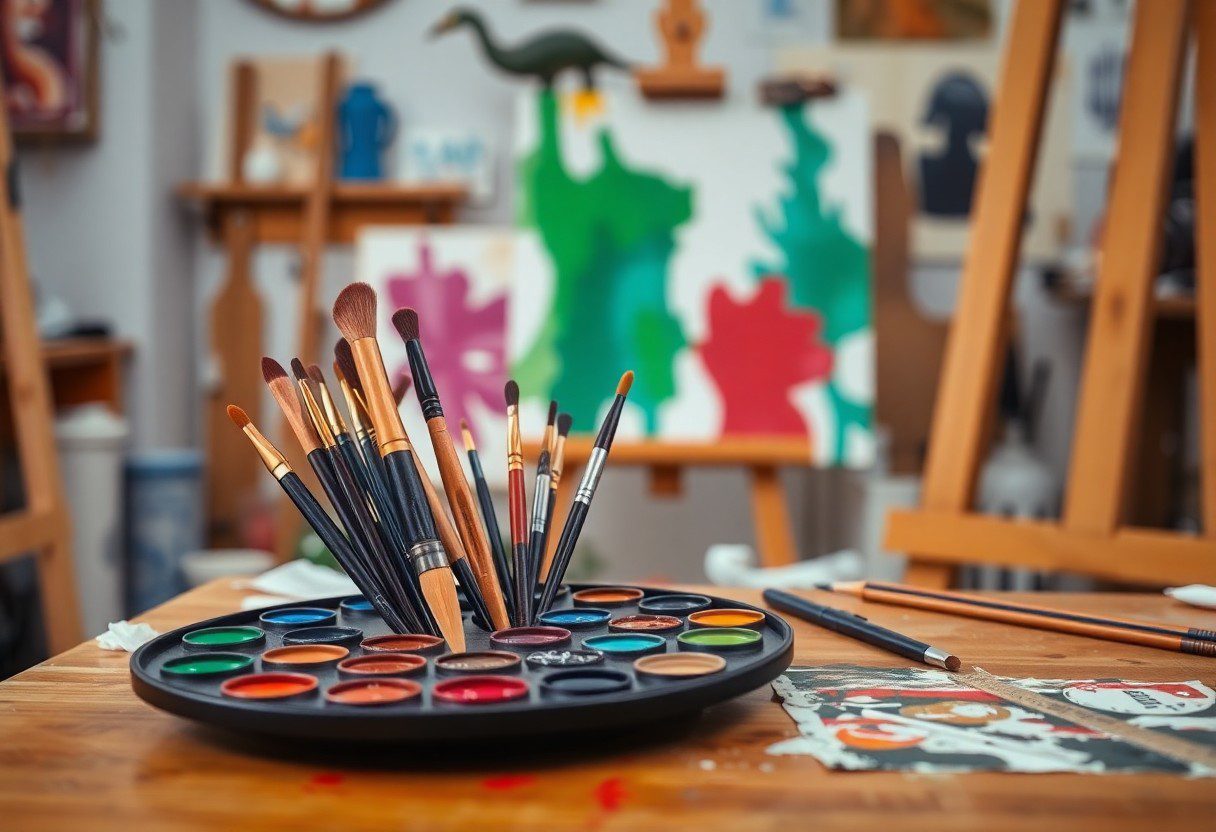You want to make the most of your acrylic painting workshop experience, and having the right approach can significantly enhance your skills. Understanding the medium is vital, so familiarize yourself with the properties of acrylic paint. Don’t hesitate to ask questions during the workshop to deepen your knowledge, and practice regularly to solidify your skills. Bringing your own materials allows you to work with what you love, while also being open to trying new techniques from your instructor. With these tips, you’ll set yourself up for a fulfilling creative journey in acrylic painting.
Understanding Acrylic Paint
Your journey in acrylic painting begins with a solid understanding of the medium itself. Acrylic paint is a versatile and fast-drying option that can mimic the qualities of both watercolor and oil paints. By familiarizing yourself with its unique properties, you’ll be better equipped to unleash your creativity and express your artistic vision during workshops.
Properties and Characteristics
Below are some key properties of acrylic paint that make it an excellent choice for artists. It dries quickly, allowing for rapid layering and techniques such as glazing. The paint is also water-resistant when dry, providing flexibility for various applications. Additionally, acrylics can be thinned for a watercolor effect or thickened for more textured techniques, catering to diverse styles and preferences.
Choosing the Right Brand
Before plunging into painting, it’s important to choose the right brand of acrylic paint that fits your needs. Not all acrylic paints are created equal; some brands offer better pigmentation and consistency, which can greatly affect the final outcome of your artwork. Investing in reputable brands can enhance your experience and results during workshops.
Right brand selection poses major challenges but can be incredibly rewarding. Opt for brands known for their high-quality pigments, as these produce vibrant colors and excellent coverage. Additionally, consider the viscosity and drying times that fit your style. More fluid paints may suit those who prefer blending, while thicker paints can facilitate texture creation. Avoid cheaper alternatives as they may lead to unpleasant surprises in your final artwork. Ultimately, choosing the right brand provides a solid foundation for your acrylic painting journey.
Essential Tools and Supplies
It’s important to come prepared with the right tools and supplies for your acrylic painting workshop. Having the right materials can significantly enhance your learning experience and enable you to express your creativity more freely. Ensure you have the basic imperatives, along with any optional tools that may inspire you. A good foundation of supplies will allow you to focus on developing your skills and exploring new techniques effectively.
Brushes and Palette Knives
Knives and brushes are indispensable tools for any acrylic painter. You should consider investing in various brush types, such as flat, round, and filbert, to create different effects in your artwork. Palette knives are also imperative for mixing colors and applying paint in unique ways. Having a diverse set of these tools will broaden your artistic possibilities and improve your overall technique.
Canvas and Surfaces
Before you start, it’s imperative to choose the right canvas or surface for your acrylic painting. Acrylics can be applied to various surfaces, such as stretched canvas, canvas boards, or watercolor paper. Each surface has its own texture and absorbency, which can dramatically impact your final outcome. Ensure you select a surface that aligns with your desired technique and style.
Another factor to consider is the texture of the canvas or surface you choose. A rough texture can add dimension and depth, while a smooth surface is ideal for fine details. Additionally, the size of your canvas should reflect your artistic vision; larger surfaces can be more expressive, while smaller ones may offer precision and control. Selecting the appropriate canvas not only influences the aesthetics of your work but also your overall experience in the workshop.
Pre-Workshop Preparation
One key to a successful acrylic painting workshop is proper pre-workshop preparation. This involves defining your artistic intent and making sure that both your mind and space are ready for creative exploration. With a little effort ahead of time, you will approach the workshop feeling organized and focused, enabling you to absorb more from the experience.
Setting Goals
Along with ensuring you have the right materials, setting clear goals for what you want to achieve during the workshop can enhance your overall experience. Whether you’re aiming to learn new techniques, express an emotion, or simply enjoy painting, having a target in mind can help you stay motivated and engaged throughout the process.
Gathering Materials
Behind every great painting lies the right set of materials. Before the workshop, ensure you have all necessary items, including brushes, paints, canvases, palettes, and any other tools recommended by your instructor. You want to avoid the stress of scrambling for supplies at the last minute.
To achieve a smooth painting experience, make a checklist of materials that your instructor suggests. This includes different sizes of brushes, a variety of acrylic paints, canvases in the size you prefer, and a sturdy palette. Consider bringing a sketchbook for jotting down ideas or preliminary sketches. Having these materials organized will not only boost your confidence but also equip you to focus on creating rather than worrying about what you’ve forgotten. Don’t forget to include items like paper towels and water containers, as these can significantly enhance your painting process.
Techniques to Enhance Your Skills
Many aspiring artists overlook the importance of mastering techniques to elevate their acrylic painting skills. By focusing on foundational practices, you can unlock new levels of creativity and expression. Spend time experimenting with different methods, and you’ll find what resonates with your unique style, helping you to refine your artistic vision.
Brush Techniques
Around the canvas, your brush techniques play a significant role in the final outcome of your artwork. Experimenting with various brush strokes can create textures and effects that will enhance your piece. Practice using different brush types, angles, and pressures while painting to gain a better understanding of how each technique can impact your work.
Layering and Blending
Between the layers of paint lies an opportunity to create depth and dimensionality in your artwork. Layering and blending techniques allow you to achieve smooth transitions and richer colors. Understand how to apply thin layers and allow them to dry before adding more to avoid muddiness in your painting.
The layering technique is vital for achieving complex colors and textures, as each thin layer builds upon the previous one, providing a sense of depth. Use blending to create soft transitions between colors by gently working wet paint together, ensuring your brushes are clean to avoid unintended color mixing. Be cautious, as over-blending can lead to a washed-out look. Instead, balance your approach to maintain vibrancy while creating the desired effects. By mastering these techniques, you’ll enhance your overall acrylic painting skills, bringing your creative vision to life.
Workshop Etiquette
All participants in an acrylic painting workshop should strive to maintain a positive and collaborative environment. Being mindful of the space around you, following the rules set by the instructor, and minimizing distractions will enhance everyone’s experience. Proper etiquette includes being punctual, keeping your workspace organized, and showing appreciation for the creative efforts of others.
Respecting Fellow Participants
On entering the workshop, you’ll immediately notice the diverse backgrounds and skill levels present. It’s important to create an atmosphere of support; this means actively listening to others, offering encouragement, and refraining from judgment. By respecting fellow participants, you contribute to a more enjoyable and productive workshop, where every individual feels valued and inspired.
Engaging with the Instructor
Instructor feedback is an crucial component of the learning process, so engaging actively with your instructor can enhance your workshop experience. Approach your instructor with specific questions about techniques or materials, and don’t hesitate to ask for clarification if something isn’t clear. Respecting their expertise not only aids your own learning but also fosters a relationship that can lead to more personalized guidance.
Respecting the instructor can deepen your understanding and skills in acrylic painting. When you ask thoughtful questions and provide attentive feedback, you create a dialogue that allows for a greater exchange of ideas. Moreover, acknowledging the instructor’s insights and methods promotes a respectful dynamic that encourages them to engage more fully with you and your fellow participants.
Overcoming Challenges
After experiencing challenges in acrylic painting workshops, it’s vital to adopt a positive mindset. Each obstacle can serve as a stepping stone for growth. By acknowledging that setbacks are a natural part of the creative process, you can maintain your motivation and focus on improvement. Embrace the unique path of your artistic journey and take each challenge as an opportunity to refine your skills.
Dealing with Frustration
Overcoming frustration is vital to your success in acrylic painting. It’s common to feel overwhelmed by your work at times. To counter this, take short breaks, practice breathing exercises, or simply step back to reassess your perspective. By allowing yourself to distance from the situation, you can return rejuvenated, clear-headed, and ready to tackle the canvas with renewed vigor.
Embracing Mistakes
Frustration often leads to the discovery of beautiful opportunities in your art practice. The key is recognizing that embracing mistakes can be a transformative experience. Each misstep can teach you valuable lessons about your technique and vision. Instead of seeing them as failures, view them as a chance to experiment, innovate, and enhance your creativity. Allow your painting journey to be about exploration rather than perfection.
Embracing mistakes enables you to explore the diversity of textures, colors, and techniques in acrylic painting. Each blunder can inspire unexpected creative outcomes. When you allow yourself the freedom to experiment, you’ll uncover new possibilities for your art that you may have never considered before. Celebrate these moments as they often become the foundation of your artistic evolution and authenticity. Note, every artist’s growth is shaped by their willingness to learn from imperfections.
Final Words
Ultimately, embracing your creativity and remaining open to feedback can greatly enhance your experience in acrylic painting workshops. As you explore different techniques and refine your skills, prioritize practice while allowing yourself the freedom to experiment. Connecting with fellow participants can also inspire new ideas and foster a supportive environment. With dedication and a positive mindset, you can maximize your learning and enjoyment in these artistic pursuits.
FAQ
Q: What should I bring to an acrylic painting workshop?
A: When attending an acrylic painting workshop, it is important to bring your own set of supplies. This typically includes acrylic paints in a variety of colors, a set of brushes ranging in size, a palette for mixing colors, a canvas or canvas board, and a cup of water for cleaning brushes. Additionally, you may want to pack an apron or old clothes to protect your attire, as acrylic paints can be difficult to remove. Consider bringing a notebook or sketchbook for jotting down notes or ideas during the workshop.
Q: How do I choose the right workshop for my skill level?
A: When selecting an acrylic painting workshop, it is beneficial to review the workshop’s description and prerequisites. Some workshops are designed for beginners, while others cater to intermediate or advanced artists. Look for classes that specify the skill level they cater to, and consider reaching out to the instructor if you have any doubts about your suitability. It’s also a good idea to check reviews or testimonials from previous participants to find a workshop that aligns with your experience and learning goals.
Q: What techniques should I focus on while in an acrylic painting workshop?
A: During an acrylic painting workshop, it is advantageous to focus on various techniques that can enhance your overall painting skills. Some important techniques to explore include blending colors, layering, glazing, and creating texture. Additionally, practicing brush strokes and experimenting with different tools, such as palette knives or sponges, can provide valuable insights into the versatility of acrylics. Be open to learning new methods and ask your instructor for personalized guidance to improve specific areas of your technique.
Q: How can I stay motivated throughout the workshop?
A: To maintain motivation during an acrylic painting workshop, set personal goals for what you want to achieve by the end of the session. Stay engaged by actively participating in discussions, asking questions, and seeking feedback on your work from both the instructor and peers. Embrace the learning process and remind yourself that mistakes can lead to valuable lessons. Surrounding yourself with other enthusiastic artists can also create a supportive atmosphere that encourages creativity and inspiration.
Q: How can I continue improving my acrylic painting skills after the workshop?
A: After completing an acrylic painting workshop, it can be beneficial to set aside regular time for practice to further develop your skills. Seek out online tutorials, books, or local art groups to expand your knowledge and techniques. Experimenting with different styles and subjects can also help you find your unique artistic voice. Consider maintaining a portfolio of your work to track your progress and set new goals. Engaging with fellow artists through social media or local meetups can provide additional motivation and support as you continue to grow in your acrylic painting journey.





